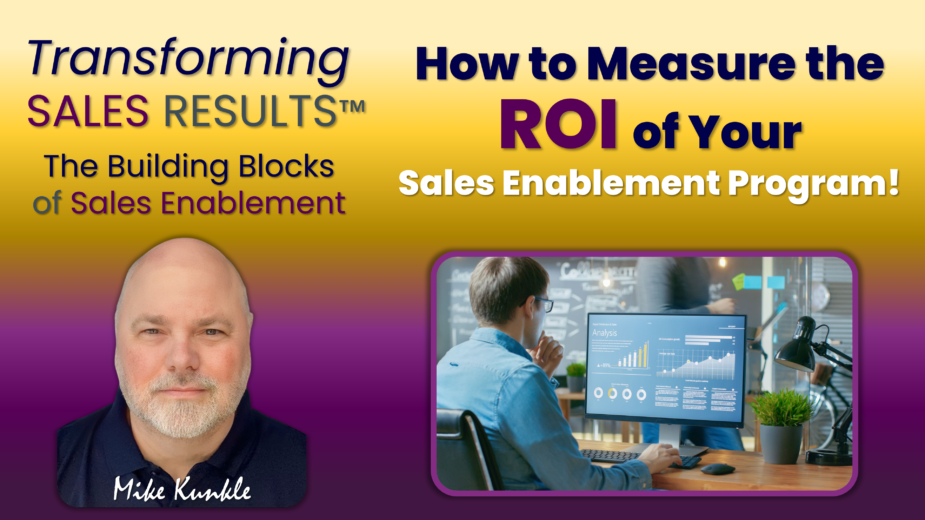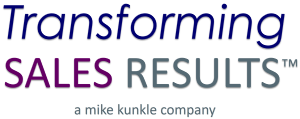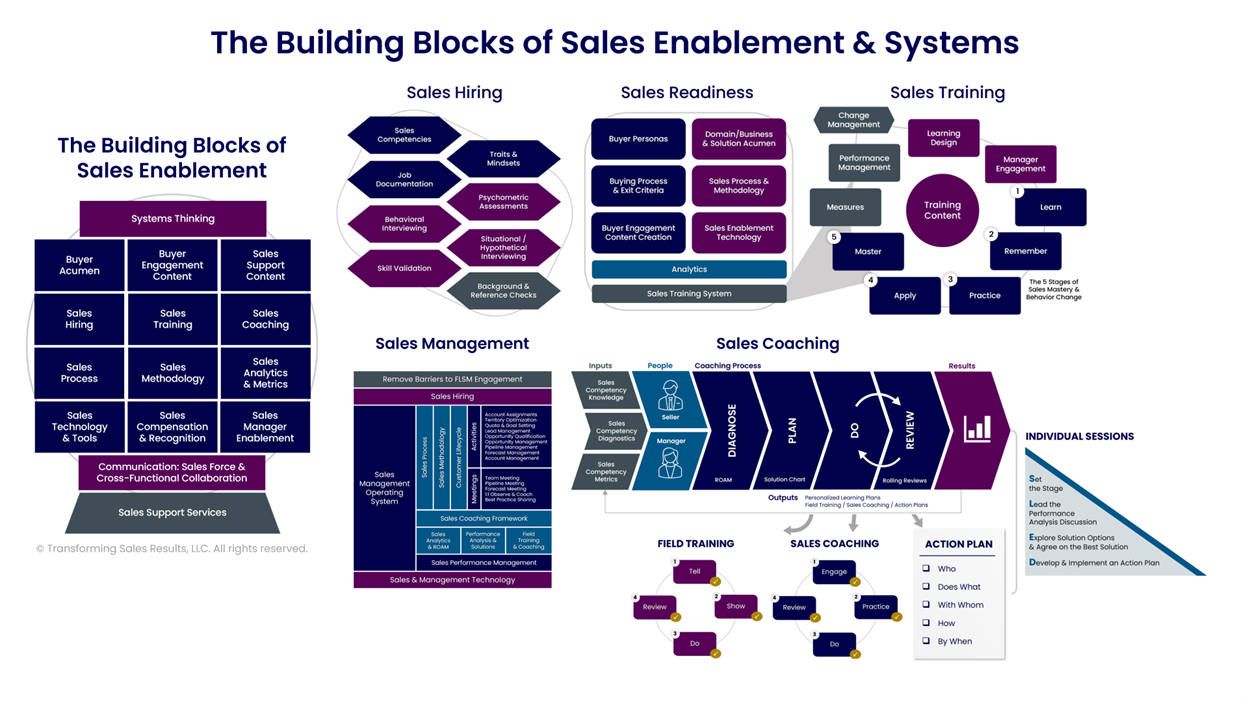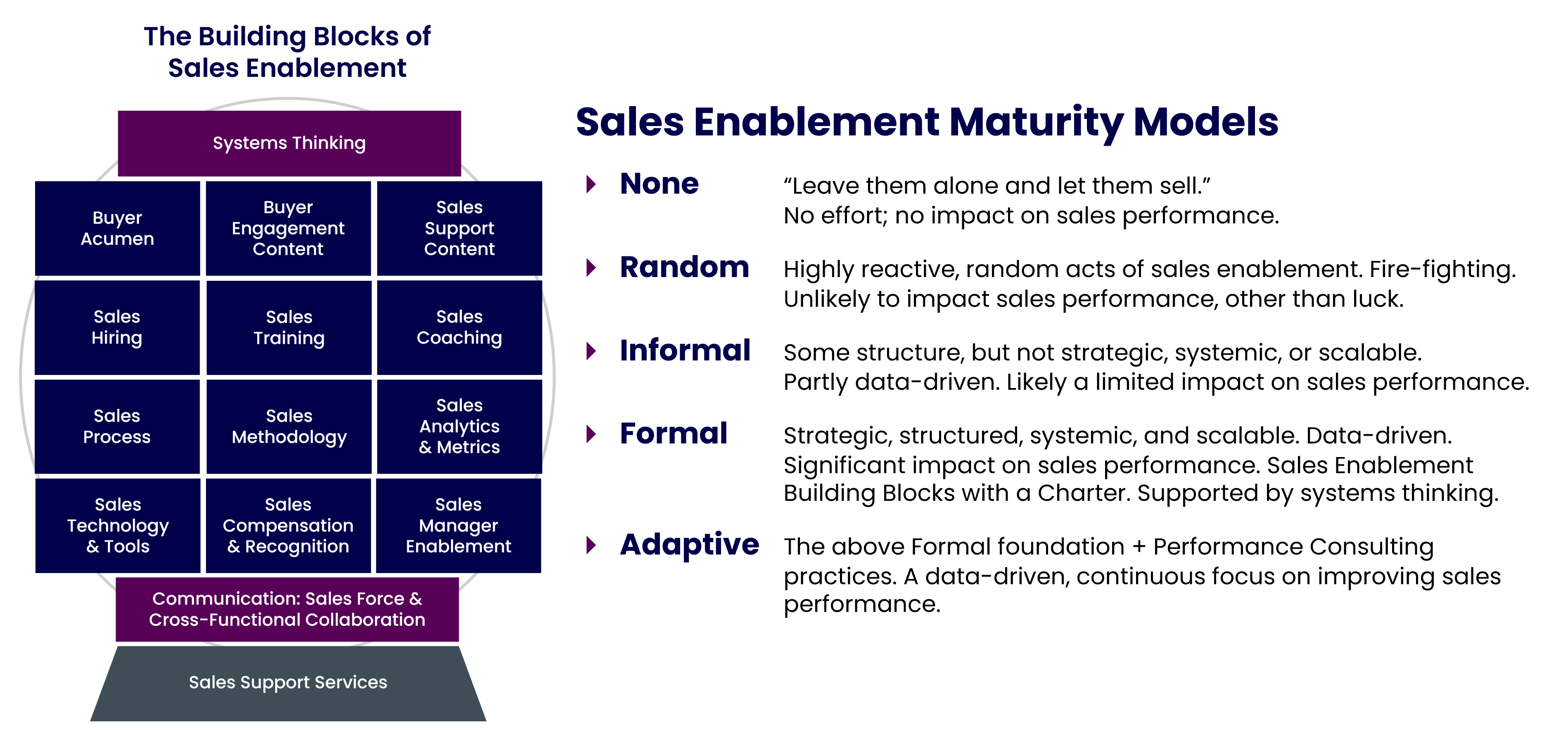How to Measure the ROI of Your Sales Enablement Program

In this post, I will offer advice about how to measure the ROI of your sales enablement program.
This is a complex topic that is beyond the scope of one blog post, but I will do my best to provide a solid kickstart for you and offer what I hope will be some helpful perspective and good resources to continue to pursue.
I do have a video on this topic, from my newsletter, Sales Enablement Straight Talk, as an additional resource. Click the link to watch on YouTube (and if you enjoy the content I create, please subscribe while you’re there): https://youtu.be/ueDMbx9Y_BQ
Introduction
Let’s level set, to get started.
Despite a hodge-podge of definitions in the market, we know that sales enablement is the act of providing sales reps with the knowledge, skills, and resources they need to achieve the highest-possible levels of sales effectiveness and to achieve organizational goals.
This doesn’t occur in a vacuum, so I’d add that the path to that end is what I refer to as an “other-centric pass-through.” Your sellers achieve what they and your company want by helping enough of your buyers and customers achieve what they want. This concept of the other-centric pass-through is often left unspoken, but I feel it’s a critical part of the equation and worth stating explicitly. This is why Buyer Acumen is the first block in the Building Blocks of Sales Enablement framework.
Then, delivering a return on investment (ROI) would mean that the gains in results achieved over time exceed the expenses invested in sales enablement. No surprise there, either.
In the best-case scenarios, those gains would also exceed the current trend line of performance (what the sales force was likely to do without enablement efforts) and deliver accretive improvements in performance. And this isn’t something I see being talked about frequently. What really matters is the improvement that can be reasonably attributed to your enablement and performance improvement efforts.
An Important Caution
In the world of evaluation and attribution, we must often agree to accept logical and reasonable evidence, versus cold, hard proof.
I’ve often joked that:
“All evaluation is a lie, and what we need to do is get together to agree on the lies that we’ll all believe.”
That’s a joke and hyperbole, but it’s not far off. The same thing applies with any ROI analysis.
If you don’t gain alignment on what you’ll measure, how you’ll analyze those results, and how you’ll report it, you are setting yourself up for failure. If those to whom you’re reporting the results can pick apart your analysis, you will lose all credibility. This concern often holds enablers back from attempting ROI analysis, but that’s not necessary. Get alignment first. Then, the rest of this makes sense and can be really valuable.
With all that said, let’s get back to ROI measurement basics. You can measure for:
- Overall Performance: such as with raw sales productivity (usually “revenue per rep in a given timeframe” but sometimes includes “percent of time spent selling”), sales velocity (opportunities x average sales price x win rate / average sales cycle), or just progress toward the attainment of the annual revenue plan (revenue plan attainment).
- Targeted Performance: meaning a specific effort focused on a KPI in need of improvement, such as decreasing Closed-Lost or No Decision rates and improving Closed-Won rates, or improving overall profitability in a certain product line where deep discounting is rampant.
[Click the image to see a larger and expanded version, with the systems]
Based on the maturity level of enablement and your business environment and context (see this post for more on the flavors of sales enablement), at a minimum, you should include training, content, tools, and ensure coaching is occurring. More advanced programs will include all aspects of The Building Blocks of Sales Enablement framework and its supporting systems (refer to the above image or click the image or above link for a full view of the blocks and supporting systems). This is how you get the Formal Maturity Model, where you have the best chance of delivering an ROI.
[Click the image to see a larger version]
A successful sales enablement program can help sales reps improve their sales skills, close more deals, and achieve their goals, and can engage, enable, and empower front-line sales managers to support them.
- For Overall Performance Improvement: Getting the foundational blocks in place and executing through the systems is a great approach. Fueled by foundational Buyer Acumen, the Sales Training System (with The 5 Stages of Sales Mastery & Behavior Change), the Sales Coaching block, and the Sales Management System (with its embedded Sales Coaching Framework) will foster a continuous improvement loop. (See this chart.)
- For Targeted Performance Improvement: Diagnostics, root-cause analysis, solution design, and disciplined execution may involve one or more blocks or systems. Multi-phased, iterative plans can continue to focus on the “next big thing” to deliver improvements on the metrics that matter most, ultimately raising overall performance, as well.
Benchmark & Measure
Obviously, measurement is a critical piece of this work. I know that many enablers do benchmark metrics and measure improvements for overall performance or targeted initiatives. One of the most important and often overlooked aspects of a sales enablement program, though, is measuring its ROI. It’s tricky, but can be done.
By measuring the ROI of your sales enablement program, you can see not only how it is impacting your sales performance and make necessary adjustments to improve its effectiveness, but also that you are doing it in a profitable way. I once saw a company spend almost half a million dollars to implement a sales methodology and gain adoption, and deliver an accretive $200K in revenue, at a 35% profit margin, to leave them $430K in a hole for the first year.
I’d disclaim in this scenario that to see big lift from a full sales methodology adoption generally takes between 6 and 36 months. That’s a big variance, I realize, but it depends on the size of the sales force and seriousness of sales leaders and front-line sales managers. It also requires a minimum of 75% adoption (of the right sales methodology) and gets statistically better again at 90% adoption, if you really want to deliver significant lift.
So, you might not see a return in the first year, and these are important expectations to set. A full-scale methodology implementation is a change management project. There should be some quick hits and low-hanging fruit, especially through improved qualification and discovery, and talking the same language and being able to coach efficiently and effectively across the sales force, but the big results come over time, as adoption and mastery increase.
SIDEBAR: In the example I provided above, the company (executive team and board) were very enamored with the vendor and would not listen to my cautions. They radically adjusted performance expectations immediately after the implementation, and set hiring targets accordingly, to support growth expectations. About a year later, the downsizing began. Other factors contributed to this, including not listening to advice about the level of reinforcement and coaching required, and ignoring a large-scale sales force competency assessment that indicated that we had many people in the wrong roles. (That was rebuffed and sat on a shelf.) It was a perfect storm of unfortunate factors and ended very poorly. About 18 months later, they were acquired.
So, there are factors beyond your control that may contribute to both sides of an ROI equation – favorable and negative. In either case, ignorance is never bliss and even if it’s just for you as a test or barometer, knowing your ROI and how you are tracking, is a wise move.
How to Measure Enablement ROI
There are a number of ways to measure the ROI of your sales enablement program. As I’ve already done above, I’ll continue to slice this by Overall Performance and Targeted Performance. And in each, we’ll segment Expenses and Outcomes.
Overall Performance
Important Disclaimer: For any advice I provide here, confirm it with your financial team and leadership team. In fact, as already mentioned above but worth repeating, I never recommend creating a measurement, analysis, evaluation, or ROI analysis plan without cross-functional collaboration and the sign-off of those who will eventually be the recipients of your analysis. Even if you’re quietly doing the analysis for yourself, at first, I would still confirm your approach with a colleague in your finance team, to ensure it aligns with the way they track and report finances. You may also want to speak with a business analyst or your resident data scientist or stats geek (or get outside counsel) about your analysis methodology, to ensure it is valid.
Expenses
- For overall performance, consider using your entire sales enablement budget (all expenses and costs) for the timeframe being analyzed.
Outcomes
- Increased sales: The most obvious way to measure the effectiveness of your sales enablement program across the organization is to track the increase in sales. This can be done by tracking metrics such as raw productivity (revenue per rep), sales velocity (the speed at which the sales force produces revenue), and gains in margin/profitability.
Other Metrics to Consider
- Consider using the “SG&A to revenue ratio” or some variation. You can compare revenue to SG&A (Selling, General, and Administrative) expenses. It’s usually calculated as SG&A as a percentage of total revenue. For enablement purposes, it might make more sense to just use Selling Expenses, or even a finer slice, perhaps just the Sales Expenses, which often includes just the salaries and wages of salespeople including commissions, payroll taxes, and benefits. If you’re unfamiliar with SG&A and what it contains, this article and this article are good starting points.
Targeted Performance
Conducting a targeted performance ROI analysis is obviously far more contextual, depending what performance and metrics you are trying to address and improve.
Expenses
Track payroll and time spent only on this initiative to diagnose, develop a solution, and implement and support the solution.
Consider payroll, time, and expenses for your sales enablement resources, of course, and, if appropriate, the other collaborators.
You might consider the percentage of time from front-line sales managers, as well. However, since those managers are already working with employees and are responsible for getting results from their team, I ask the executive team to whom results will be reported whether their costs should be included. There are pro/con rationales on both sides of the equation, and the only thing that matters is alignment on “the lies you will all believe.” If decision makers want it included to “make the ROI analysis more believable” (and reduce the ROI produced), then agree on what percentage of FLSMs time and costs should be calculated in expenses, and do the math.
Outcomes
In this case, you’ll be benchmarking one or a few specific, related metrics. In the example above I mentioned win rates, which could include Closed-Lost, No Decision, and Closed-Won. Or, it might be overall profitability for a specific product line.
Whatever you’re tracking, I recommend benchmarking historic metrics over in a timeframe that makes sense, versus freezing benchmarks for one month (such as the last month before the initiative began). When possible, I look back over the length of the average sales cycle. If the sales cycle is short, I look back across a few sales cycles.
I like to do a year-over-year comparison in some cases, and when seasonality is a factor in your business, you’ll want to factor in seasonality. The idea is to establish a performance trend line of what is expected to happen, whenever possible, rather than one static number. In other words, based on current performance and any YoY or seasonality factors, what’s the likely performance outcome for the next X months, if you do nothing? Map that trajectory, and now you have a baseline to compare to, to show you’ve delivered accretive results, beyond what would have happened anyway.
If you do have seasonality trends, and you benchmark at a low point and begin your initiative at the beginning of a seasonality ramp-up, your analysis may falsely suggest improvement that is not a result of your efforts. That’s a guaranteed way to immediately lose credibility with executives.
Other Metrics to Consider
- Sales costs: Sales costs include the costs of sales training, content development, and sales tools. By tracking sales costs, you can see how your sales enablement program is helping you save money, or how the investments are supporting the accretive growth you’ve delivered.
- Improved customer satisfaction: Customer satisfaction is a measure of how satisfied customers are with your products and services and their buying or customer experience. By tracking customer satisfaction, you can see how your sales enablement program is helping you create a better customer experience. This should also allow you to correlate stick rates/customer retention improvements, reduced churn, and account growth. Don’t assume correlation means causation, but if you see patterns you can report them.
Another method for measuring pre-post initiative results, for either of the above scenarios (overall or targeted) is to benchmark a number of months leading up to the start of the initiative, and measure a number of months after the initiative, and compare pre- and post-results. Again, for accuracy, it makes sense to adjust this analysis for seasonality or YOY comparisons, as well as for any other factors that may have affected the post-timeframe (marketing campaigns, price changes, comp plan changes, new product launches, etc.). As long as your analysis team is aligned on the approach, this “pre-results bucket, compared to post-results bucket” is a fair analysis approach.
The Best Metrics for Your Business
The best metrics for your business will depend on your primary KPIs and your specific goals and strategic objectives in the current/next reporting period.
For example, if your goal is to increase sales (the number of sales) or revenue (dollar volume), then you will want to focus on metrics such as sales productivity, sales velocity, and win rates. If your goal is to improve sales productivity, then you might want to focus on metrics such as leads generated, conversions, qualifications stats, sales per rep, and average deal size. This is highly contextual and something you’ll need to dig into with your execs, sales leader(s), your sales or revenue operations team, your finance team, and/or your business analysts.
How to Set Up a Measurement System
To set up a measurement system for your sales enablement program, you will need to:
- Identify the metrics you want to track (expenses and outcomes). Consider all the feedback from above.
- Collect data on those metrics.
- Analyze the data to identify trends and patterns.
- Make adjustments to your sales enablement program based on your findings.
Here are some additional tips for measuring the ROI of your sales enablement program:
- Set realistic goals. When setting goals for your sales enablement program, make sure they are realistic and achievable. This will help you avoid setting yourself up for failure.
- Track the right metrics. Not all metrics are created equal. When choosing metrics to track, make sure they are relevant to your goals and objectives.
- Collect data consistently. To get accurate results, you need to collect data consistently over time. This will help you identify trends and patterns in your sales performance.
- Use a variety of data sources. Don’t rely on just one data source to measure the ROI of your sales enablement program. Get data from a variety of sources, such as CRM software, sales reports, and customer surveys.
- Iterate & make adjustments as needed. The results of your measurement system should guide your decisions about how to improve your sales enablement program. If you see that certain metrics are not improving, make adjustments to your program accordingly.
By following these tips, you can measure the ROI of your sales enablement program and ensure that it is effective and efficient.
Closing Thoughts
Measuring the ROI of your sales enablement program is essential to ensure that it is effective and efficient. By getting alignment upfront on metrics, analysis, and reporting approaches, tracking the right metrics, making adjustments to your program as needed, and reporting as agreed, you can improve your company’s sales performance and fully demonstrate your department’s value.
NEED SUPPORT?
If you, your department, or executive team would benefit from advisory services or coaching on this or similar topics in 2024, download this document to see packages and options, or complete the form on the bottom of this page, to explore options together.
RESOURCES
- Article: Phillips’ ROI Model on Whatfix
- Article: 6 Training Evaluation Models on Whatfix
- Article: How to Measure Your Sales Enablement ROI on CustomerThink
- Article & Links: Thalheimer’s LTEM Model on Work-Learning Research (with multiple links/downloads)
- eBook: The Complete Guide to Sales Enablement ROI by Allego (gated download)
- My Newsletter: Mastering Sales Diagnostics for Enablement
- My Newsletter: How to Adapt the Building Blocks to Your Situation
- My Newsletter: The Power of a Continuous Improvement Loop
- My Slide Deck: Improve Sales Performance Using the Metrics That Matter
- Book: ROI Fundamentals by Jack Phillips
- Book: Measuring ROI in Learning & Development by Jack and Patti Phillips
- Books: All of Jack Phillips’ Books on Amazon
If you have questions, issues, or just want to share successes, please don’t hesitate to reach out to me and let me know.
Thanks for reading, be safe out there, and by all means… let’s continue to elevate our sales profession and #MakeAnImpact With #Enablement!
Mike
Follow my work and connect
- The Building Blocks of Sales Enablement Book: https://bit.ly/BBofSE
- The Building Blocks of Sales Enablement Course: https://GoFFWD.com/Blocks
- Sales Enablement Straight Talk Newsletter: https://bit.ly/MikeKunkle-LinkedInNewsletter
- SPARXiQ Blog: https://sparxiq.com/author/mikekunkle
- Distribution Strategy Group Blog: https://distributionstrategy.com/author/mike-kunkle/
- Sales Effectiveness Straight Talk Webinars: https://bit.ly/MikeKunkle-OnDemand(60 Free Recorded Webinars)
- LinkedIn Articles: http://bit.ly/MK-LinkedInArticles
- LinkedIn Profile: https://www.linkedin.com/in/mikekunkle
- X (formerly Twitter): https://twitter.com/mike_kunkle
- Instagram: https://www.instagram.com/mike_kunkle/
- TikTok: https://www.tiktok.com/@mike_kunkle
- YouTube: https://www.youtube.com/@MikeKunkle/videos (Please Subscribe!)
About Mike
Mike Kunkle is a recognized expert on sales training, sales effectiveness, and sales enablement. He’s spent over 30 years helping companies drive dramatic revenue growth through best-in-class training strategies and proven-effective sales transformation systems – and he’s delivered impressive results for both employers and clients. Mike is the founder of Transforming Sales Results, LLC and works as the Vice President of Sales Effectiveness Services for SPARXiQ, where he designs sales training, delivers workshops, and helps clients improve sales results through a variety of sales effectiveness services. Mike collaborated with Doug Wyatt to develop SPARXiQ’s Modern Sales Foundations™ curriculum and also authored the SPARXiQ’s Sales Coaching Excellence™ course. His book, The Building Blocks of Sales Enablement, is available on Amazon and The Building Blocks of Sales Enablement Learning Experience is available through FFWD.


